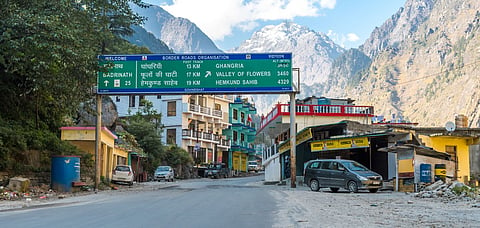

Joshimath, the gateway for mountain climbing expeditions, trekking, and other thrilling activities for those who want to live on the edge, has been hit by a geological phenomenon known as land subsidence.
Over the last few months, homes and other manmade structures in the city of 20,000 people, started developing cracks, eventually forcing many families to abandon their homes and move to safer locations.
Subsidence is a progressive settling or lowering of the surface brought on by the loss of water, oil, natural gas, or mineral resources from the earth.
A Popular Tourist Spot
Located approximately 300 km from Dehradun, Joshimath is considered the starting point from where one moves on to the spectacular Valley of Flowers and the Hemkund Sahib Gurudwara. It is also a base for those heading to Auli and the Malari and Niti Valleys, known for their stark high-altitude landscapes.
The city boasts enchanting views of the Himalayan ranges and is known for its varied flora and fauna. It is located at a distance of only 46 km from the Badrinath temple, one of the top pilgrimage spots for Hindus.
The Tale Till Now
Joshimath is situated on the Himalayan foothills and is flanked by two rivers, which according to environmental specialists, makes it particularly vulnerable to earthquakes, landslides, and erosion.
During a geological survey of Joshimath in August 2022, a team assembled by the state government of Uttarakhand discovered that the pace of land erosion had accelerated that year, with residents attributing this to heavy rainfall in October 2021 and catastrophic flash flooding earlier in the same year. This raised questions about the region's vulnerability to climate change.
According to the study, numerous homes in Joshimath had significant damage, and others were "unsafe for human habitation" and constituted a "severe risk" to the people living there. The report advocated halting buildings in some sections and cited apparent fissures in the city's walls, floors, and along numerous routes as proof that the city was sinking.
However, construction has been continuing until last week.
Now, all building projects in Joshimath, including those on a bypass road and the National Thermal Power Corporation's (NTPC) Tapovan Vishnugad hydropower project, have been temporarily halted on January 5 by the district administration. Authorities evacuated about 100 households last week and hastened the arrival of specialists to ascertain the reason.
Effect On Tourism
Sooraj Kotiyal, who runs and manages a hotel called "Saidham," near Auli Road, told OT that there are no tourists to be seen in the city at a time which used to be the peak season for them.
"In January and February, Joshimath used to be full of tourists. But there are none now. The only people staying in my hotel are families who were asked to move out of their homes. You could see the cracks on the road roughly a few hundred meters from my hotel."
Kotiyal added that he foresees his business gradually moving towards "zero."
On the other hand, Ajay Bhatt, who runs a homestay in Joshimath and two resorts in Auli, is slightly more optimistic about the situation. Though he accepts that there are "no tourists" in the city and cracks can be seen roughly 100 meters from his Joshimath homestay, he believes in the power of nature.
"If we stop messing with nature, it will heal itself because the situation in Joshimath is man-made. We should give the city some time to recover," Bhatt said.
What Do Experts Say
Bangalore-based environmentalist V. Selvarajan, founder and secretary of Green Circle Delhi, a 30-year-old group of volunteer green activists in Delhi, evaluates Joshimath's situation as "grim" and one that "is inching towards a major disaster."
"The hills are overstressed with the growing population of locals and tourists on one hand and indiscriminate construction on the other," he said.
Selvarajan also shed light on the fact that cracks can also be seen in Karnaprayag, 82 km away from Joshimath.
"Cracks can be found in many other areas like Uttarkashi, Nainital, Gopeshwar and Mussoorie. Whenever there's a cloudburst, landslide or flashflood, investigation agencies do a general spot inspection but not a geological, geophysical or hydrological investigation."
Linking the Joshimath tragedy and tourism, Selvarajan elaborated the building boom in the hills is a result of an increasing influx of tourists.
"But what's the point of so much development and hotel construction that everything has to shut down one day"
ALSO READ Stargazing In Uttarakhand
RELATED Uttarakhand Into The Silence
